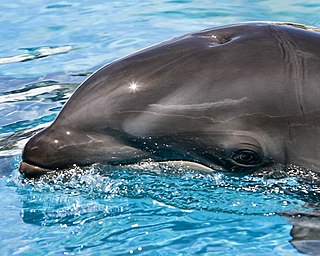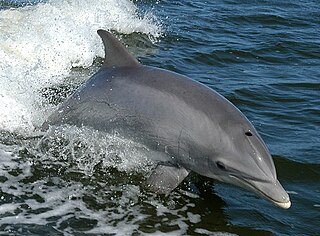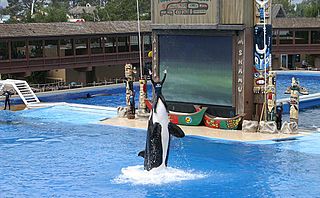Related Research Articles

Cetacea is an infraorder of aquatic mammals belonging to the order Artiodactyla that includes whales, dolphins and porpoises. Key characteristics are their fully aquatic lifestyle, streamlined body shape, often large size and exclusively carnivorous diet. They propel themselves through the water with powerful up-and-down movement of their tail which ends in a paddle-like fluke, using their flipper-shaped forelimbs to maneuver.

A dolphin is an aquatic mammal in the clade Odontoceti. Dolphins belong to the families Delphinidae, Platanistidae, Iniidae, Pontoporiidae, and possibly extinct Lipotidae. There are 40 extant species named as dolphins.

A wholphin(portmanteau of whale and dolphin) is an extremely rare cetacean hybrid born from a mating of a female common bottlenose dolphin with a male false killer whale. The name implies a hybrid of whale and dolphin, though taxonomically, both are in the oceanic dolphin family, which is in the toothed whale clade. This type of hybrid was considered unexpected given the sometimes extreme size difference between a female common bottlenose dolphin and a male false killer whale. Wholphins have been born in captivity and have also been reported in the wild.

The bottlenose dolphin is a toothed whale in the genus Tursiops. They are common, cosmopolitan members of the family Delphinidae, the family of oceanic dolphins. Molecular studies show the genus contains three species: the common bottlenose dolphin, the Indo-Pacific bottlenose dolphin, and Tamanend's bottlenose dolphin. Others, like the Burrunan dolphin, may be alternately considered their own species or be subspecies of T. aduncus. Bottlenose dolphins inhabit warm and temperate seas worldwide, being found everywhere except for the Arctic and Antarctic Circle regions. Their name derives from the Latin tursio (dolphin) and truncatus for the truncated teeth.

Oceanic dolphins or Delphinidae are a widely distributed family of dolphins that live in the sea. Close to forty extant species are recognised. They include several big species whose common names contain "whale" rather than "dolphin", such as the Globicephalinae. Delphinidae is a family within the superfamily Delphinoidea, which also includes the porpoises (Phocoenidae) and the Monodontidae. River dolphins are relatives of the Delphinoidea.

The toothed whales are a clade of cetaceans that includes dolphins, porpoises, and all other whales with teeth, such as beaked whales and the sperm whales. 73 species of toothed whales are described. They are one of two living groups of cetaceans, the other being the baleen whales (Mysticeti), which have baleen instead of teeth. The two groups are thought to have diverged around 34 million years ago (mya).

Cetacean intelligence is the overall intelligence and derived cognitive ability of aquatic mammals belonging in the infraorder Cetacea (cetaceans), including baleen whales, porpoises, and dolphins. In 2014, a study found for first time that the long-finned pilot whale has more neocortical neurons than any other mammal, including humans, examined to date.

SeaWorld is an American theme park chain with headquarters in Orlando, Florida. It is a proprietor of marine mammal parks, oceanariums, animal theme parks, and rehabilitation centers owned by United Parks & Resorts. The parks host shows starring marine mammals, especially dolphins and pinnipeds, as well as zoological displays featuring various other marine animals.

The common bottlenose dolphin or Atlantic bottlenose dolphin is one of three species of bottlenose dolphin in the genus Tursiops. The common bottlenose dolphin is a very familiar dolphin due to the wide exposure it receives in human care in marine parks and dolphinariums, and in movies and television programs. Common bottlenose dolphins inhabit temperate and tropical oceans throughout the world, absent only from polar waters. While formerly known simply as the bottlenose dolphin, this term is now applied to the genus Tursiops as a whole. As considerable genetic variation has been described within this species, even between neighboring populations, many experts think additional species may be recognized.

An animal sanctuary is a facility where animals are brought to live and to be protected for the rest of their lives. Pattrice Jones, co-founder of VINE Sanctuary defines an animal sanctuary as "a safe-enough place or relationship within the continuing hazards that menace everybody". In addition, sanctuaries are an experimental staging ground for transformative human–animal relations. There are five types of animal sanctuaries reflective of the species-belonging of the residents: 1) companion animal sanctuaries; 2) wildlife sanctuaries; 3) exotic animal sanctuaries; 4) farmed animal sanctuaries; and 5) cetacean sanctuaries.
Louis Herman was an American marine biologist. He was a researcher of dolphin sensory abilities, dolphin cognition, and humpback whales. He was professor in the Department of Psychology and a cooperating faculty member of the Department of Oceanography at the University of Hawaiʻi at Mānoa. He founded the Kewalo Basin Marine Mammal Laboratory (KBMML) in Honolulu, Hawaii in 1970 to study bottlenose dolphin perception, cognition, and communication. In 1975, he pioneered the scientific study of the annual winter migration of humpback whales into Hawaiian waters. Together with Adam Pack, he founded The Dolphin Institute in 1993, a non-profit corporation dedicated to dolphins and whales through education, research, and conservation.

Dolphin drive hunting, also called dolphin drive fishing, is a method of hunting dolphins and occasionally other small cetaceans by driving them together with boats, usually into a bay or onto a beach. Their escape is prevented by closing off the route to the open sea or ocean with boats and nets. Dolphins are hunted this way in several places around the world including the Solomon Islands, the Faroe Islands, Peru, and Japan, which is the most well-known practitioner of the method. In large numbers dolphins are mostly hunted for their meat; some end up in dolphinariums.

A marine mammal park is a commercial theme park or aquarium where marine mammals such as dolphins, beluga whales and sea lions are kept within water tanks and displayed to the public in special shows. A marine mammal park is more elaborate than a dolphinarium, because it also features other marine mammals and offers additional entertainment attractions. It is thus seen as a combination of a public aquarium and an amusement park. Marine mammal parks are different from marine parks, which include natural reserves and marine wildlife sanctuaries such as coral reefs, particularly in Australia.

The Tethys Research Institute is a non-profit research organisation founded in 1986 to support marine conservation through science and public awareness and by participating in the international conservation process. Tethys' activities are mainly carried out in the Mediterranean Sea, although research programmes have been conducted also in the Black Sea, the North Atlantic Ocean, the Caribbean, the Red Sea and Antarctica. The results of these activities have been presented in scientific publications as well as in meetings, workshops and conferences.

Dawn Therese Brancheau was an American animal trainer at SeaWorld. She worked with orcas at SeaWorld Orlando for fifteen years, including a leading role in revamping the Shamu show, and was SeaWorld's poster girl. She was killed by an orca, Tilikum, who was also involved in the deaths of Keltie Byrne and Daniel P. Dukes.

Tilikum, nicknamed Tilly, was a captive male orca who spent most of his life at SeaWorld Orlando in Florida. He was captured in Iceland in 1983; about a year later, he was transferred to Sealand of the Pacific near Victoria, British Columbia, Canada. He was subsequently transferred in 1992 to SeaWorld in Orlando, Florida, where he sired 21 calves throughout his life.
Diana Reiss is a professor of psychology at Hunter College and in the graduate program of Animal Behavior and Comparative Psychology at the City University of New York. Reiss's research has focused on understanding cognition and communication in dolphins and other cetaceans. Her important contributions include demonstrating mirror self-awareness in dolphins via the Mirror test.

Blackfish is a 2013 American documentary film directed by Gabriela Cowperthwaite. It concerns Tilikum, an orca held by SeaWorld and the controversy over captive orcas. The film premiered at the 2013 Sundance Film Festival on January 19, 2013, and was picked up by Magnolia Pictures and CNN Films for wider release. It was nominated for the BAFTA Award for Best Documentary.

My Pilot, Whale is a short documentary film directed by Alexander and Nicole Gratovsky, demonstrating direct communication between a human and free pilot whales in the open ocean.

Susan Casey is a Canadian born writer. She has been lead editor of Sports Illustrated Women and O, The Oprah Magazine and she has written several non-fiction books including The Devil's Teeth concerning sharks in the Greater Farallones National Marine Sanctuary in California.
References
- ↑ Mirror self-recognition in the bottlenose dolphin: A case of cognitive convergence
- ↑ Hoare, Philip (2015-09-09). "Voices in the Ocean: A Journey into the Wild and Haunting World of Dolphins by Susan Casey – review". The Guardian. ISSN 0261-3077 . Retrieved 2023-06-28.